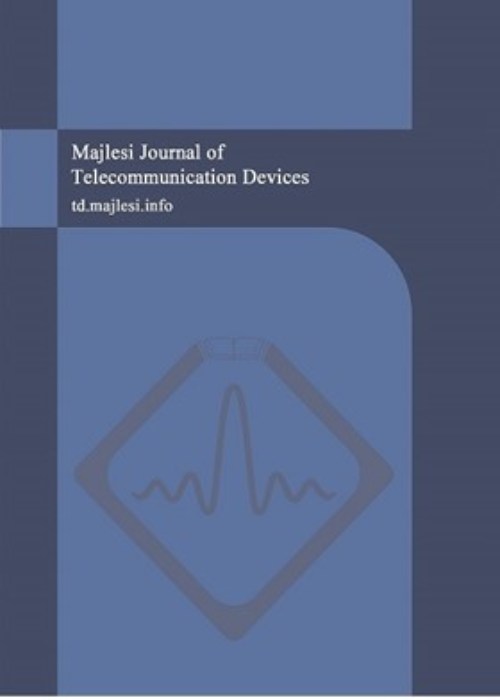فهرست مطالب
Majlesi Journal of Telecommunication Devices
Volume:3 Issue: 4, Dec 2014
- تاریخ انتشار: 1393/12/19
- تعداد عناوین: 6
-
Pages 129-131Switching is a principle process in digital computers and signal processing systems. The growth of optical signal processing systems, draws particular attention to design of ultra-fast optical switches. In this paper to investigate the operation of the photonic crystal switches, several methods are described. Among different methods, FDTD is a preferable method and is used. We have studied the application of photonic crystal lattices, the physics of optical switching and different types of all optical photonic crystal switches. In this paper, an all optical switch based on photonic crystal directional coupler has been simulated and analyzed by the finite difference time domain (FDTD) method. In this paper, a different structures with changes in central row rods (0.12a) in all optical directional coupler switch have been proposed then electric field intensity and the power output that are two factors to improve the switching performance and the device efficiency, have been investigated and simulated by using COMSOL software.
-
Pages 133-137In this paper, a GaAs pHEMT class A balanced power amplifier with a 3-dB bandwidth of 4.5 GHz at the center frequency of 9 GHz is presented. Our amplifier yields to an input/output-matching better than -15 dB over this frequency band. Also, the realization of impedance matching network using microstrip line and lumped component is carried out. At the end, simulation results for the broadband impedance matching network are presented and analyzed
-
Pages 139-143This paper deals with linear behavior and distortion of class-D amplifier. calculation approach and effective terms on the distortion of amplifier is also carried out. the typical circuit of class-D amplifier CMCD is considered. Traditional approaches have been analyzed the distribution amount in class-D amplifier in voltage mode (VMCD) simulation result has been compared with mathematical approaches of amplifier. This comparison validate the effectiveness of mentioned terms on third harmonic distortion amounts.
-
Pages 145-151Charge Coupled Devices (CCDs) are one of the best sensors for use in space explorations which is described as a closely spaced array of metal-oxide semiconductor (MOS) that allows collection,storage and transfer of charge. It is utilized for a large range of wave length including UV to visible light. The experiments done on these space sensors, show that using them in environments with ionizing radiations can regard their functionality. Generally we can summarize the mechanism of these radiation damages in two category: Total Ionizing Dose effects(TID) and Displacement Damage effects(DD). DD effects result in Charge Transfer Efficiency(CTE) reduction, dark current noise increase and etc. In this article we have proceed the simulation of CTE degradation and related parameters for a model of CCD that is CCD58. These studies utilise the package ISE-TCad software.Then we have compared and have validated our simulation results with the experimental data from laboratory measurements. The experimental measurements have been carried out by researchers at the University of Liverpool.
-
Pages 153-157In this paper a novel RF MEMS cantilever type switch with low actuation voltage is presented. The cantilever beam of switch is supported by two L-shaped springs to reduce the spring constant. The switch is simulated using Intellisuite software. The actuation voltage of switch is achieved about 2 volt and the size of the switch is 110×60µ2m, that in compared with other electrostatic cantilever beam switch, it has a small size, low spring constant and as a result low actuation voltage. Its fabrication is simple due to its simple design. The S-parameters of switch have been simulated with HFSS 9.1 that the results show the insertion loss of 0.07 dB, return loss 0f 25 dB and 17 dB isolation for V, Ka frequencies band. The results show proper performance of switch in this frequencies band and it had less insertion loss compare pervious work and with these properties of switch, return loss and isolation did not changed much.
-
Pages 159-162In this paper, we used photonic crystal resonant cavity structure for designing a 2-channel optical wavelength demultiplexer. It has been shown that by using photonic crystal resonant cavity, wavelength separation is possible. In order to select 2 channels with different central wavelengths we employed 2 resonant cavities with different structural parameters. The platform used for designing the proposed demultiplexer is a hexagonal lattice of dielectric rods immersed in air. The demultiplexer has 2 channels with central wavelengths equal to l1=1549.4 nm and l2=1551.2 nm. The transmission efficiency of the demultiplexer is more than 92%. The quality factors for first and second channels are 1936 and 3021 respectively.


